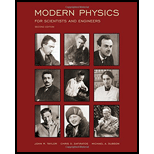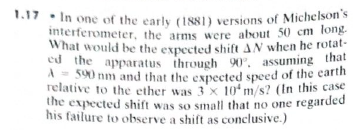
Modern Physics For Scientists And Engineers
2nd Edition
ISBN: 9781938787751
Author: Taylor, John R. (john Robert), Zafiratos, Chris D., Dubson, Michael Andrew
Publisher: University Science Books,
expand_more
expand_more
format_list_bulleted
Question
Chapter 1, Problem 1.17P

To determine
To find:
The expected shift
Expert Solution & Answer
Want to see the full answer?
Check out a sample textbook solution
Students have asked these similar questions
(a) In communicating with an astronaut on the moon, 3.8 x 108 m from earth, what is the minimum time delay in getting a
response to a question?
(b) What would the minimum time delay be for communication with an astronaut at a distance of 2 light-years from earth?
One of the difficulties with the Michelson Morley experiment is that several extraneous effects (mechanical vibrations, variations of temperature, etc) can produce unwanted shifts in the interference pattern, masking the expected shift of interest. Suppose, for example, that during the experiment the temperature of one arm of the interferometer were to rise by deltaT. This would increase the arm’s length (L) by delta(L) =aLdeltaT, where a=10-5 is the arm’s coefficient of expansion. a) Symbolically, express the shift delta(N) that this temperature change would cause (in terms of a, L, deltaT, and lamda).b) Calculate deltaN for lamda=590nm, L=50cm, and deltaT=0.01 C. c) Make a conclusion about the importance of careful temperature control in the experiment by comparing result in b) with the expected shift deltaN (without temperature correction). Hint: we calculated the expected shift in class for different dimensions of the Michelson Interferometer.
Muons are unstable subatomic particles that decay to electrons with a mean lifetime of 2.2 µs. They are produced when cosmic rays bombard the upper atmosphere about 10 km above the earth’s surface, and they travel very close to the speed of light. The problem we want to address is why we see any of them at the earth’s surface. (a) What is the greatest distance a muon could travel during its 2.2 µs lifetime? (b) According to your answer in part (a), it would seem that muons could never make it to the ground. But the 2.2 µs lifetime is measured in the frame of the muon, and muons are moving very fast. At a speed of 0.999c, what is the mean lifetime of a muon as measured by an observer at rest on the earth? How far would the muon travel in this time? Does this result explain why we find muons in cosmic rays? (c) From the point of view of the muon, it still lives for only 2.2 µs, so how does it make it to the ground? What is the thickness of the 10 km of atmosphere through which the muon…
Chapter 1 Solutions
Modern Physics For Scientists And Engineers
Ch. 1 - Prob. 1.1PCh. 1 - Prob. 1.2PCh. 1 - Prob. 1.3PCh. 1 - Prob. 1.4PCh. 1 - Prob. 1.5PCh. 1 - Prob. 1.6PCh. 1 - Prob. 1.7PCh. 1 - Prob. 1.8PCh. 1 - Prob. 1.9PCh. 1 - Prob. 1.10P
Ch. 1 - Prob. 1.11PCh. 1 - Prob. 1.12PCh. 1 - Prob. 1.13PCh. 1 - Prob. 1.14PCh. 1 - Prob. 1.15PCh. 1 - Prob. 1.16PCh. 1 - Prob. 1.17PCh. 1 - Prob. 1.18PCh. 1 - Prob. 1.19PCh. 1 - Prob. 1.20PCh. 1 - Prob. 1.21PCh. 1 - Prob. 1.22PCh. 1 - Prob. 1.23PCh. 1 - Prob. 1.24PCh. 1 - Prob. 1.25PCh. 1 - Prob. 1.26PCh. 1 - Prob. 1.27PCh. 1 - Prob. 1.28PCh. 1 - Prob. 1.29PCh. 1 - Prob. 1.30PCh. 1 - Prob. 1.31PCh. 1 - Prob. 1.32PCh. 1 - Prob. 1.33PCh. 1 - Prob. 1.34PCh. 1 - Prob. 1.35PCh. 1 - Prob. 1.36PCh. 1 - Prob. 1.37PCh. 1 - Prob. 1.38PCh. 1 - Prob. 1.39PCh. 1 - Prob. 1.40PCh. 1 - Prob. 1.41PCh. 1 - Prob. 1.42PCh. 1 - Prob. 1.43PCh. 1 - Prob. 1.44PCh. 1 - Prob. 1.45PCh. 1 - Prob. 1.46PCh. 1 - Prob. 1.47PCh. 1 - Prob. 1.48PCh. 1 - Prob. 1.49PCh. 1 - Prob. 1.50PCh. 1 - Prob. 1.51PCh. 1 - Prob. 1.52PCh. 1 - Prob. 1.53P
Knowledge Booster
Learn more about
Need a deep-dive on the concept behind this application? Look no further. Learn more about this topic, physics and related others by exploring similar questions and additional content below.Similar questions
- Two astronomical events are observed to occur at a time of 0.30 s apart and a distance separation of 2.0109m from each other. How fast must a spacecraft travel from the site of one event toward the other to make the events occur at the same time when measured in the frame of reference of the spacecraft?arrow_forward(a) In communicating with an astronaut on the moon, 3.8E8 m from earth, what is the minimum time delay in getting a response to a question? (b) What would the minimum time delay be for communication with an astronaut at a distance of 4 light-years from earth?arrow_forwardIf a galaxy moving away from the Earth has a speed of 1000 km/s and emits 656 nm light characteristic of hydrogen (the most common element in the universe). (a) What wavelength would we observe on the Earth? (b) Whattype of electromagnetic radiation is this? (c) Why is the speedof the Earth in its orbit negligible here?arrow_forward
- (a) How long in seconds does it take a radio signal to travel 180 km from a transmitter to a receiving antenna? (b) We see a full Moon by reflected sunlight. How much earlier did the light that enters our eye leave the Sun? The Earth – Moon and Earth – Sun distances are 3.8x105 km and 1.5 × 108 km, respectively. (c) What is the round-trip travel time in seconds for light between Earth and a spaceship at a 6.8 × 107 km distance from Earth? (d) Suppose astronomers observe a supernova about 7300 light-years (ly) distant. How long ago in years did the explosion actually occur?arrow_forwardIn the 1887 experiment by Michelson and Morley, the length of each arm was 11 m. The experimental limit for the fringe shift was 0.005 fringes. If sodium light was used with the interferometer ( λ=589 nm), what upper limit did the null experiment place on the speed of the Earth through the expected ether?arrow_forwardEarth's neighboring galaxy, the Andromeda Galaxy, is a distance of 2.54 × 107 light-years from Earth. If the lifetime of a human is taken to be 85.0 years, a spaceship would need to achieve some minimum speed Umin to deliver a living human being to this galaxy. How close to the speed of light would this minimum speed be? Express your answer as the difference between Umin and the speed of light c. 8.96 ×10¹3 C- Umin m/s Incorrectarrow_forward
- Michelson-Morley Experiment. A shift of one fringe in the Michelson-Morley experiment corresponds to a change in the round-trip travel time along one arm of the interferometer by one period of vibration of light (about 2 X 10-15 s) when the apparatus is rotated by 90. Based on the results of such experiment, what velocity through the ether would be deduced from a shift of one fringe? (Take the length of the interferometer arm to be 11 m.)arrow_forwardA galaxy G is moving away radially with speed with respect to an observer O. The relation between X, the wavelength of light emitted at G, and λo, the wavelength observed at O, is 入。 λ = λe λε 1+B 1- B' = where ẞ v/c (c is the speed of light). For ẞ < 1 find a power series expansion of the above formula up to and including terms of order ẞ³.arrow_forwardA shift of onefringe in the Michelson-Morley experiment corresponds to a change in the round-trip travel time along one arm of the interferometer by one period of vibration of light (about 2 ×10−15s) when the apparatus is rotated by 90◦. Based onthe results of such experiment,what velocity through the ether would be deduced from a shift of one fringe? (Take the length of the interferometer arm to be 11 m.)arrow_forward
- calculate: (a) the real andimaginary part of fı2)= 32-i (b) the real andimaginary part of f(zl=22²-2 c() the abselute va lw of fiz) =z²arrow_forwardYour video analysis of the motion of a marble gives it position in frame 23 as (x23, Y23) = (0.134 m, 0.120 m) and its position in frame 24 as (x24, 324) = (0.122 m, 0.112 m). You esti- mate that you can measure the r and y positions with uncertainty +0.003 m. The frame rate of the video is 30 frames/s, which means the time interval between frames is At = 0.033 333 s. The uncertainty of the frame rate of a video camera is VERY small. For the sake of this prob- lem, use 8(At) = 1 x 10-6 s. The mass of the marble is (2.031 +0.001) x 10-2 kg. Calculate the following quantities: 4. The value of the momentum component p = mv, and its uncertainty, 5. The value of the momentum component py = muy and its uncertainty, and 6. The value of the kinetic energy K = mv² = m(v² + v²) and its uncertainty.arrow_forwardIf a galaxy moving away from the Earth has a speed of 1000 km/s and emits 656 nm light characteristic of hydrogen (the most common element in the universe). (a) What wavelength would we observe on the Earth?arrow_forward
arrow_back_ios
SEE MORE QUESTIONS
arrow_forward_ios
Recommended textbooks for you
 University Physics Volume 3PhysicsISBN:9781938168185Author:William Moebs, Jeff SannyPublisher:OpenStax
University Physics Volume 3PhysicsISBN:9781938168185Author:William Moebs, Jeff SannyPublisher:OpenStax Physics for Scientists and Engineers: Foundations...PhysicsISBN:9781133939146Author:Katz, Debora M.Publisher:Cengage Learning
Physics for Scientists and Engineers: Foundations...PhysicsISBN:9781133939146Author:Katz, Debora M.Publisher:Cengage Learning Classical Dynamics of Particles and SystemsPhysicsISBN:9780534408961Author:Stephen T. Thornton, Jerry B. MarionPublisher:Cengage Learning
Classical Dynamics of Particles and SystemsPhysicsISBN:9780534408961Author:Stephen T. Thornton, Jerry B. MarionPublisher:Cengage Learning Principles of Physics: A Calculus-Based TextPhysicsISBN:9781133104261Author:Raymond A. Serway, John W. JewettPublisher:Cengage Learning
Principles of Physics: A Calculus-Based TextPhysicsISBN:9781133104261Author:Raymond A. Serway, John W. JewettPublisher:Cengage Learning

University Physics Volume 3
Physics
ISBN:9781938168185
Author:William Moebs, Jeff Sanny
Publisher:OpenStax

Physics for Scientists and Engineers: Foundations...
Physics
ISBN:9781133939146
Author:Katz, Debora M.
Publisher:Cengage Learning

Classical Dynamics of Particles and Systems
Physics
ISBN:9780534408961
Author:Stephen T. Thornton, Jerry B. Marion
Publisher:Cengage Learning

Principles of Physics: A Calculus-Based Text
Physics
ISBN:9781133104261
Author:Raymond A. Serway, John W. Jewett
Publisher:Cengage Learning
Time Dilation - Einstein's Theory Of Relativity Explained!; Author: Science ABC;https://www.youtube.com/watch?v=yuD34tEpRFw;License: Standard YouTube License, CC-BY